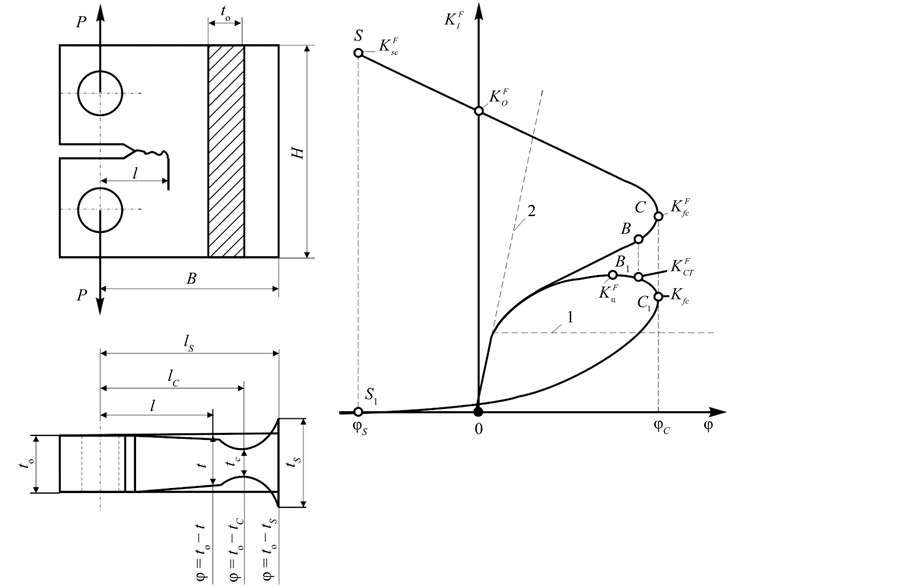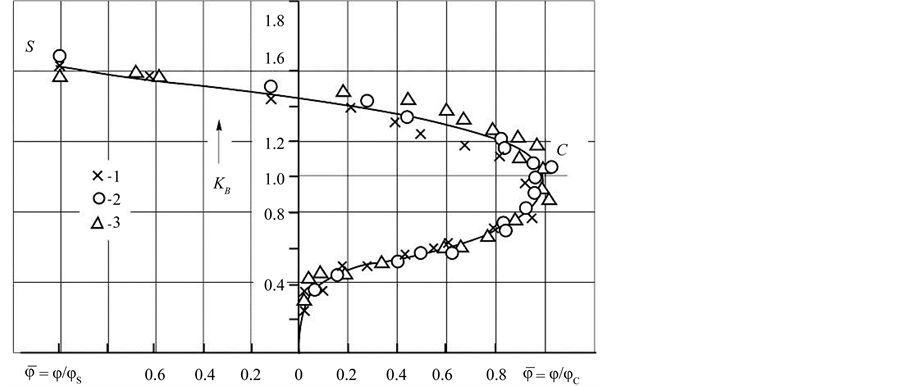World Journal of Mechanics
Vol.05 No.05(2015), Article ID:56272,5 pages
10.4236/wjm.2015.55009
Cyclic Elasto-Plastic Fracture Diagram and Some Parameters of Cyclic Crack Growth Resistance for the Plastic Steels
L. A. Sosnovskiy1, A. V. Bogdanovich2, S. S. Sherbakov2
1S&P Group “TRIBO-FATIGUE”, Gomel, Belarus
2Department of Theoretical and Applied Mechanics, Belarusian State University, Minsk, Belarus
Email: bogal@tut.by, sherbakovss@mail.ru
Copyright © 2015 by authors and Scientific Research Publishing Inc.
This work is licensed under the Creative Commons Attribution International License (CC BY).
http://creativecommons.org/licenses/by/4.0/



Received 13 March 2015; accepted 10 May 2015; published 13 May 2015
ABSTRACT
Method of calculation and experimental estimation of crack growth resistance under cyclic elasto- plastic deformation is proposed. This method is based on measuring of local plastic strain near the crack tip and plotting the cyclic elasto-plastic fracture diagram for a specimen with a crack. Analysis of two types of the cyclic elasto-plastic fracture diagrams and their parameters is made. Experimental D-diagrams of cyclic elasto-plastic fracture for the plastic carbon steel are given.
Keywords:
Crack Growth Resistance, Elasto-Plastic Deformation, Compact Specimen, Plastic Steel, Stress Intensity Factor, Contraction

1. Introduction
A significant influence on strength and life of the structures is conditioned by manufacturing defects and operational nature which often become the cause of fatigue cracks. Evaluation of the crack resistance of structures made from plastic steel based on the approaches of nonlinear fracture mechanics is problematic due to non- compliance of the conditions of plane strain. One solution to the problem is in the extrapolation of formulas of linear elastic fracture mechanics for stress intensity factor (SIF) on essentially nonlinear stage of deformation using functions of plasticity amendments. Analytical and experimental method for the estimation of crack growth resistance under cyclic elasto-plastic deformation [1] based on measuring of local plastic strain near the crack tip end is discussed further.
2. Diagram Construction Method
Considering that plastic steel was subjected to test an estimation of applicability of basic formulas of linear elastic fracture mechanics was made. Observance of flat deformation conditions was checked by criteria [2] - [5] :
 (1)
(1)
 (2)
(2)
where  is stress intensity factor;
is stress intensity factor;  is a nominal thickness of the compact specimen;
is a nominal thickness of the compact specimen;  is a thickness of the compact specimen with the account of elasto-plastic strains;
is a thickness of the compact specimen with the account of elasto-plastic strains;  is yield strength (offset = 0.2%) of a material;
is yield strength (offset = 0.2%) of a material;  is relative contraction of cross-section of the specimen (Figure 1).
is relative contraction of cross-section of the specimen (Figure 1).
It has appeared that conditions Equation (1) and Equation (2) are not satisfied for the investigated steel in the upper part of the fatigue crack growth diagram. Formulas of linear elastic fracture mechanics for the estimation of SIF value of the standard compact tension specimen [2] -[4]
 (3)
(3)
where  is the maximum load of a cycle; l is the measured length of a crack;
is the maximum load of a cycle; l is the measured length of a crack; , B are the sizes of a dangerous section of the specimen (Figure 1);
, B are the sizes of a dangerous section of the specimen (Figure 1);  is the correction function which considers geometry of the specimen and its scheme of loading:
is the correction function which considers geometry of the specimen and its scheme of loading:
 (4)
(4)
is also correct for elastic deformation under preservation of flat deformation conditions. In order to apply them to elasto-plastic domain it is necessary to correct them for plasticity.
It can be realized by taking into account in Equation (4) the actual sizes of dangerous cross-section of the specimen, i.e. those sizes that take place under plastic deformation [1] [6] -[9] .
Let us multiply and divide the relation  by
by  value; thus
value; thus . Means,
. Means,
 . At elastic deformation this equality is identical. Taking into account plastic defor-
. At elastic deformation this equality is identical. Taking into account plastic defor-
mation of dangerous cross-section of the specimen in function Y it is necessary to accept the actual thickness 


where 



Thus Equation (4а) considers not only geometry of the specimen and its scheme of loading but also integrally the size of plastic strain in dangerous cross-section. And in Equation (3а) the local measure of damage of a specimen with a crack 
It should also be stressed out that the measure 








3. Two Types of CEPF-Diagram
There are two types of CEPF-diagram [8] [9] . If for calculation of 


The CEPF-diagram generally consists of two curves: a curve of cyclic elasto-plastic destruction (sections ОВС in D-diagram and 












Figure 1. Schemes: test of the compact specimen and measurement of the thickness reduction (a); cyclic elasto-plastic fracture diagram for a specimen with a crack (b).
cyclic rupture and is characterized by parameter


4. Analytical Description of CEPF-Diagram
It is offered three expressions for the analytical description of ОВС curve at D-diagram [6] [8] [9] . The first is a power equation

where 





The second dependence for the description of a curve of cyclic elasto-plastic destruction ОВС looks like:

where 










Figure 2. D-diagrams of the cyclic elasto-plastic fracture for the carbonic steel constructed by the results of tests of compact samples of 10 (1), 20 (2) and 40 (3) mm thickness.
Figure 3. Generalized D-diagrams of the cyclic elasto-plastic fracture for the carbonic steel constructed by the results of tests of compact samples of 10 (1), 20 (2) and 40 (3) mm thickness.
be defined for them as such value 


curve (see Figure 1(b)) in co-ordinates

found from the same graph as a tangent of an angle of an inclination of the received straight line to an axis of abscises.
For obtaining the third expression it is accepted that experimental points in an average part of ОВС part of the D-diagram are approximated by a straight line in co-ordinates

where



Figure 2 shows CEPF-diagrams (analytical description of which was given above) for compact specimens of different thickness made of the plastic carbonic steel. Influence of specimen sizes on deformation characteristics of crack growth resistance is visible on Figure 2. And in Figure 3 the same diagrams are combined in the form of one dependence SIF-specimen contraction by means of the offered similarity transformation. It is shown how the stated approach can be used for an estimation of pipes survivability.
References
- Sosnovskiy, L.A. and Bogdanovich, A.V. (2011) Crack Growth Resistance. BelSUT, Gomel, 169-254.
- Е-647 (2000) Standard Test Method for Measurement of Fatigue Crack Growth Rates.
- E-339 (1976) Standard Test Method for Plane-Strain Fracture Toughness of Materials. Annual Book of ASTM Standards, 471-490.
- РД 50-345-82 (1982) Calculations and Tests for Strength. Methods of Mechanical Tests of Metals. Definition of Crack Growth Resistance Characteristics (Viscosity of Destruction) at Cyclic Loading. Methodical Instructions. Moscow.
- Drozdovsky, B.А. and Morozov, E.M. (1976) Methods of an Estimation of Viscosity of Destruction. Zavodskaya Laboratoriya, 8, 916-1004.
- Sosnovskiy, L.A. (1990) Cyclic Elasto-Plastic Fracture Diagram for a Specimen with a Crack and Its Basic Points. Vesty AS BSSR, series of phis.-tech. sciences, 2, 3-7.
- Sosnovskiy, L.A., Hamaza, L.A. and Babich, N.K. (1990) Experimental Research of Cyclic Crack Growth Resistance of Steel 20. Problems of Strength, 6, 34-38.
- Sosnovskiy, L.A. and Bogdanovich, A.V. (1995) The Analysis of Cyclic Elasto-Plastic Fracture Diagram for a Specimen with a Crack. Part 1. Problems of Strength, 5-6, 39-51.
- Sosnovskiy, L.A. and Bogdanovich, A.V. (1995) The Analysis of Cyclic Elasto-Plastic Fracture Diagram for a Specimen with a Crack. Part 2. Problems of Strength, 5-6, 52-61.
- Sosnovskiy, L.A. (1987) Statistical Mechanics of Fatigue Fracture. Science and Technics, Minsk.



